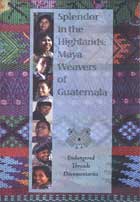
Splendor in the Highlands: Maya Weavers of Guatemala 2005
Distributed by Endangered Threads Documentaries, 1530 Tuolumne St., Vallejo, CA 94590
Produced by Endangered Threads Documentaries
Directed by Kathleen Mossman Vitale
DVD, color, 27 min.
Jr. High - Adult
Art, Anthropology, Central American Studies
Date Entered: 05/02/2011
Reviewed by Kim Stanton, University of North Texas LibrariesThis review looks at two films, Splendor in the Highlands: Maya Weavers of Guatemala and Saving the Weavers: Small Assistance Programs for Maya Women in Highland Guatemala. Both were produced by a small nonprofit organization, Endangered Threads Documentaries, whose films fall into a niche area that focuses on recording and providing education on indigenous art forms that are at risk of disappearing.
Splendor in the Highlands is a fairly short film that provides a breadth of information on traditional Mayan textile creation in various areas of Guatemala’s highland region. The film primarily concentrates on examples of women working various types of looms, creating diverse patterns and producing different styles of traditional garments, such as huipiles, trajahes and ribbons. Each styles of weaving and design is tied back to the community from which it originated and traditionally served to identify the wearer with their specific community. The examples and terminology go by quickly and aren’t always explained in a comprehensive manner. Instructors using this resource to introduce students to Mayan weaving techniques may want to supplement this film with a print resource that simply defines the concepts, while allowing the film serve as a demonstration of the techniques.
Saving the Weavers focuses on efforts being made to preserve Mayan textile traditions, which are in danger of disappearing due of globalization and cultural homogenization. The film highlights seven small assistance groups that aim to promote and aid Mayan garment workers through different means. The origins, management and goals of each group are fairly unique, though several of them do share a focus on exporting garments and accessories to the US as a main source of revenue. Other aid efforts covered by the groups include weaver coops and artisan guilds, display of works or techniques in a museum setting, workshops and eco-tourism.
Presented as a pair, these films could easily be used in non profit, public administration and business studies as an in depth example of how different organization have created organizational and business plans that address a specific need. Shown on its own, Splendor in the Highlands is a good resource for textile studies and modern anthropology. These films are both recommended.